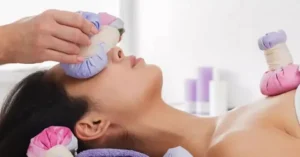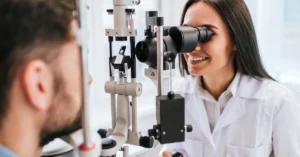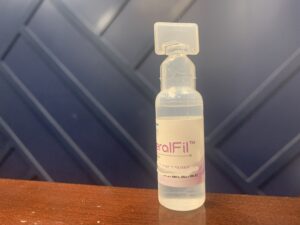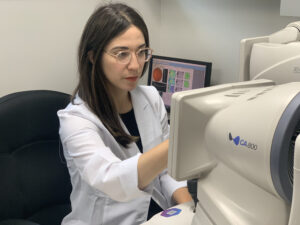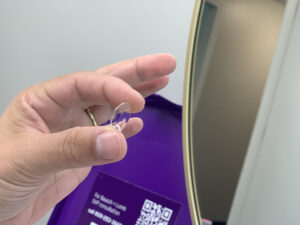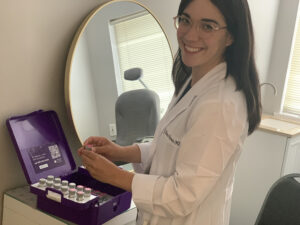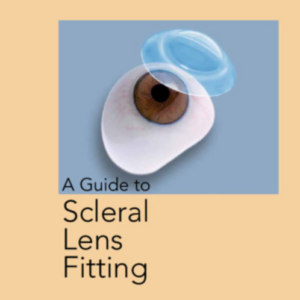Scleral contact lenses are a specialized type of contact lens that provides a comfortable and effective solution for various eye conditions. Let’s take a closer look at what scleral contact lenses are and how they work.
What Are Scleral Contact Lenses?
Scleral contact lenses are larger in diameter compared to traditional contact lenses. They are designed to vault over the cornea, resting on the sclera, the white part of the eye. Unlike regular contact lenses that sit directly on the cornea, scleral lenses create a protective reservoir of fluid between the lens and the cornea. This unique design offers several benefits for individuals with specific eye conditions.
Scleral lenses are typically made from highly breathable materials that allow oxygen to reach the cornea, promoting eye health and reducing the risk of complications. These lenses are custom-designed and fitted by eye care professionals to ensure a proper fit and optimal vision correction.
To learn more about the fitting process, refer to our article on Scleral Lens Fitting.
How Do Scleral Contact Lenses Work?
Scleral contact lenses work by creating a tear-filled reservoir on the front surface of the eye. This reservoir helps to improve vision and provides relief for individuals with certain eye conditions. When the lens is inserted, it forms a smooth and continuous surface over the irregularities of the cornea, resulting in improved vision clarity.
The space between the back surface of the lens and the cornea acts as a fluid reservoir, providing constant lubrication and hydration to the eye. This is particularly beneficial for individuals with extremely dry eyes, as the constant presence of the fluid helps to alleviate discomfort and keep the eyes moist. For more information on scleral lenses for dry eyes, refer to our article on scleral lenses for dry eyes.
Scleral lenses also play a crucial role in managing conditions like keratoconus and post-RK surgery. For individuals with keratoconus, the rigid and smooth surface of the scleral lens helps to correct the irregular shape of the cornea, improving vision and reducing distortions. Similarly, for individuals who have undergone radial keratotomy (RK) surgery, scleral lenses provide better visual outcomes by smoothing out the corneal irregularities caused by the surgery.
To learn more about the benefits of scleral lenses for post RK surgery patients, refer to our article on scleral lenses for post RK surgery.
In summary, scleral contact lenses are a valuable tool in the field of vision correction. Their unique design and custom fitting offer relief and improved vision for individuals with various eye conditions. If you’re considering scleral lenses, it’s essential to consult with an eye care professional who can guide you through the fitting process and ensure the best possible outcome for your specific needs.
Scleral Contacts for Extreme Dry Eyes
Individuals with extremely dry eyes often experience discomfort, irritation, and vision problems. Standard contact lenses may exacerbate these symptoms, making it challenging to find suitable solutions. However, scleral contacts can provide much-needed relief for those suffering from extremely dry eyes.
Causes and Symptoms of Extreme Dry Eyes
Extreme dry eyes, also known as severe dry eye syndrome, can result from various factors, including medical conditions, environmental factors, and certain medications. Common causes of extreme dry eyes include:
Dry Eye Disease:
This condition occurs when the eyes do not produce enough tears or when the tears evaporate too quickly, leading to dryness and discomfort.
Sjögren’s Syndrome:
An autoimmune disorder that primarily affects the moisture-producing glands, leading to dry eyes and dry mouth.
Medications:
Certain medications, such as antihistamines, decongestants, and antidepressants, can contribute to dry eyes as a side effect.
Environmental Factors:
Dry climates, windy conditions, and prolonged exposure to air conditioning or heating systems can all contribute to dry eyes.
Age:
As individuals age, their tear production may decrease, leading to dry eyes.
Symptoms of extremely dry eyes can include persistent dryness, a gritty or foreign body sensation in the eyes, burning or stinging, redness, and blurred vision. If you experience these symptoms, it is important to consult with an eye care professional for an accurate diagnosis and appropriate treatment.
How Scleral Contacts Can Provide Relief
Scleral contacts are specially designed to address the needs of individuals with extreme dry eyes. These contact lenses have a larger diameter than traditional lenses and vault over the cornea, resting on the sclera (the white part of the eye). This design creates a reservoir of tear-like fluid between the lens and the cornea, providing constant lubrication and moisture to the eye.
By encapsulating the entire cornea, scleral lenses help to protect the ocular surface and reduce dryness. The reservoir of fluid acts as a barrier, preventing the rapid evaporation of tears and maintaining a stable environment for the eyes. Additionally, the tear film between the lens and the cornea promotes healing and soothes the symptoms of dry eyes.
To ensure optimal fit and comfort, it is crucial to get a professional fitting for scleral contacts. During the fitting process, an eye care specialist will carefully measure the dimensions of your eyes and customize the lenses accordingly. This personalized approach helps to maximize the benefits of scleral contacts and minimize any potential discomfort.
If you are considering scleral contacts for extremely dry eyes, it is important to consult with an eye care professional who specializes in fitting these lenses. They will be able to assess your specific needs and provide guidance on the most suitable options for you.
For more information on scleral lenses and their benefits, check out our article on Scleral Lenses for Dry Eye.
Remember, proper care and maintenance are essential for the longevity and effectiveness of scleral contacts. Your eye care professional will provide instructions on the appropriate cleaning solutions and techniques to keep your lenses clean and comfortable. Regular follow-up visits will also ensure that your scleral contacts continue to provide the relief you need for your extremely dry eyes.
Scleral Contacts for Keratoconus
What is Keratoconus?
Keratoconus is a progressive eye condition that affects the shape of the cornea, the clear front surface of the eye. In individuals with keratoconus, the cornea gradually thins and bulges into a cone-like shape, causing visual distortion. This can lead to various vision problems, such as blurred vision, increased sensitivity to light, and difficulty seeing at night.
The exact cause of keratoconus is still unknown, but it is believed to involve a combination of genetic and environmental factors. It often starts during adolescence or early adulthood and can progress over time, affecting both eyes to varying degrees.
How Scleral Contacts Can Help Manage Keratoconus
Scleral contacts are an effective option for managing keratoconus and improving visual acuity for individuals with this condition. These specialized contact lenses have a larger diameter than traditional contact lenses, allowing them to vault over the irregularly shaped cornea and rest on the sclera, the white part of the eye.
By creating a smooth and uniform refractive surface, scleral lenses help to correct the distorted vision caused by keratoconus. The space between the back surface of the lens and the cornea acts as a reservoir for a saline solution, providing continuous hydration to the cornea and improving comfort for the wearer.
Moreover, the design of scleral lenses ensures that the cornea is protected from exposure to the air, reducing symptoms of dryness and irritation commonly associated with keratoconus. The lens acts as a barrier, maintaining a stable and moisturized environment for the cornea throughout the day.
When fitted properly by professional, scleral contact provide better visual acuity and comfort for individuals with keratoconus. The fitting process involves taking precise measurements of the eye and selecting the appropriate lens size and shape. For more information on the fitting process, you can refer to our article on scleral lens fitting.
It’s important to note that scleral lenses for keratoconus require a prescription and professional guidance. If you suspect you have keratoconus or are experiencing vision problems, consult an eye care professional who can assess your condition and determine if scleral contacts are a suitable option for you.
Meet Dr Shira Kresch for urgent treatment for Scleral Lens
Scleral Contacts for Post-RK Surgery
Understanding Post-RK Surgery Challenges
Refractive keratotomy (RK) surgery is a procedure that reshapes the cornea to correct vision problems such as nearsightedness or astigmatism. While RK surgery can be effective in improving vision, it can also lead to certain challenges and complications, particularly in the long term.
After RK surgery, some patients may experience residual refractive errors or irregular corneal shape, which can cause visual disturbances like glare, halos, and reduced visual acuity. These challenges can significantly impact a patient’s quality of life and may require additional interventions to address them effectively.
Benefits of Scleral Contacts for Post-RK Surgery Patients
Scleral contact lenses have emerged as a valuable option for individuals who have undergone RK surgery and continue to experience visual difficulties. These specialized contact lenses offer a range of benefits for post RK surgery patients, helping to improve visual acuity and alleviate symptoms associated with the irregular corneal shape.
One of the main advantages of scleral contacts is their ability to create a smooth and uniform optical surface over the cornea. The lenses vault over the cornea, resting on the sclera (the white part of the eye), which helps to mask any irregularities in the corneal shape. This smooth optical surface assists in reducing visual distortions and enhances clarity of vision.
Furthermore, scleral contacts provide a reservoir of moisture between the lens and the cornea, which can be particularly beneficial for post RK surgery patients who may experience dry eye symptoms. The space between the lens and the cornea acts as a protective barrier, keeping the cornea hydrated and reducing discomfort associated with dryness.
Scleral contacts also offer the advantage of customized fitting. Each lens is individually designed and fitted to ensure optimal comfort and vision correction for the specific needs of the patient. The fitting process involves precise measurements and evaluation by an eye care professional to ensure a proper fit and maximize the benefits of the lenses.
It’s important to note that the fitting of scleral contacts for post RK surgery patients requires expertise and experience. Consulting with an eye care professional who specializes in fitting scleral lenses is crucial to achieving the best possible outcomes. They will assess the patient’s unique ocular characteristics and determine the appropriate lens parameters for optimal visual correction.
By addressing the challenges associated with post RK surgery, scleral contact lenses offer a promising solution for patients seeking improved visual acuity and enhanced quality of life. If you’re interested in learning more about scleral lenses or finding a specialist near you, check out our article on scleral lenses near me.
Getting Fitted for Scleral Contacts
When considering scleral contacts as a solution for your eye condition, it is crucial to undergo a professional fitting process. This ensures that the lenses are customized to your specific needs and provide optimal comfort and vision correction. Let’s explore the importance of a professional fitting and what you can expect during the fitting process.
The Importance of a Professional Fitting
A professional fitting for scleral contacts is vital for several reasons. Firstly, an eye care professional, such as an optometrist or ophthalmologist, will assess your eye health and determine if scleral contacts are suitable for your condition. They will evaluate factors such as the shape of your eye, the severity of your condition, and any underlying issues that may affect the fitting process.
Additionally, a professional fitting allows the eye care specialist to take precise measurements of your eyes. This includes the size and curvature of your cornea, the distance between your pupils, and the overall shape of your eye. These measurements are crucial for ensuring that the scleral contacts fit properly and provide optimal vision correction and comfort.
Lastly, a professional fitting provides an opportunity for you to ask questions and learn about proper care and maintenance of your scleral contacts. The eye care professional can guide you on topics such as cleaning solutions, insertion and removal techniques, and the importance of regular follow-up visits.
What to Expect During the Fitting Process
During the fitting process, the eye care professional will follow a series of steps to ensure the best fit for your scleral contacts. Here is an overview of what you can expect:
Initial Consultation:
The process begins with an initial consultation, where you will discuss your eye condition, symptoms, and desired outcome. The eye care professional will ask questions and gather information to determine if scleral contacts are the right option for you.
Eye Examination:
Next, the eye care professional will perform a comprehensive eye examination. This may include tests to evaluate your visual acuity, eye health, and the shape of your cornea. These tests help the professional understand your specific needs and determine the appropriate parameters for your scleral contacts.
Measurement and Customization:
Using specialized instruments, the eye care professional will measure various aspects of your eyes, such as the size and curvature. These measurements are essential for ordering customized scleral contacts that fit your eyes precisely.
Trial Fitting:
In some cases, a trial fitting may be conducted to assess the fit and comfort of the scleral contacts. This involves placing diagnostic lenses on your eyes to evaluate the fit and make any necessary adjustments.
Education and Follow-Up:
Once the fitting is complete, the eye care professional will provide detailed instructions on how to insert, remove, and care for your scleral contacts. They will also schedule follow-up visits to monitor your progress and make any necessary modifications to ensure optimal comfort and vision correction.
Remember, the fitting process is a collaborative effort between you and the eye care professional. Be sure to communicate any concerns or questions you may have during the process to ensure the best outcome.
Getting fitted for scleral contacts is a crucial step towards finding relief for your eye condition. Through a professional fitting, you can ensure that your scleral contacts are customized to your specific needs, providing optimal comfort, and improving your vision. Reach out to an eye care professional near you to begin your journey towards better eye health and vision correction.





